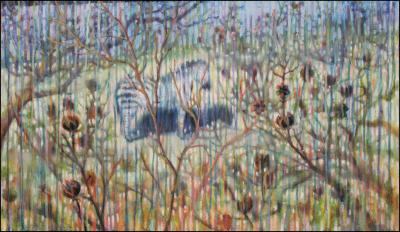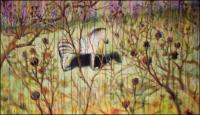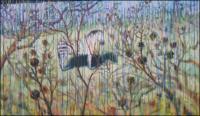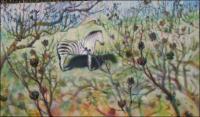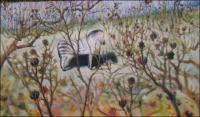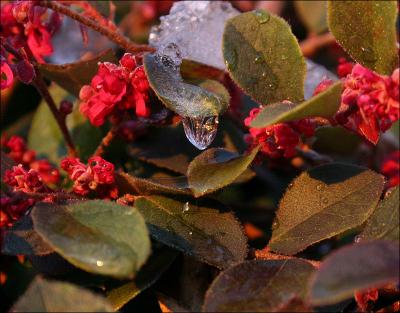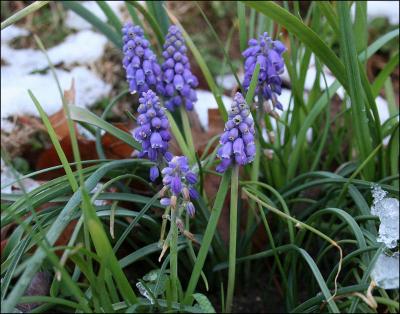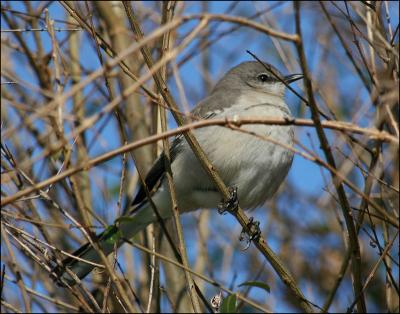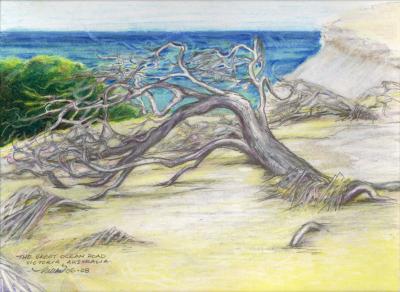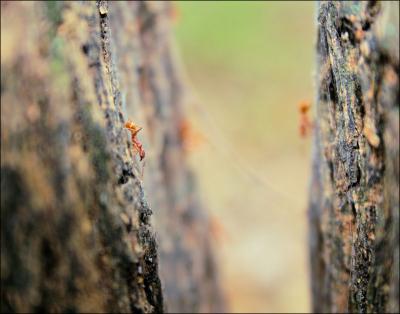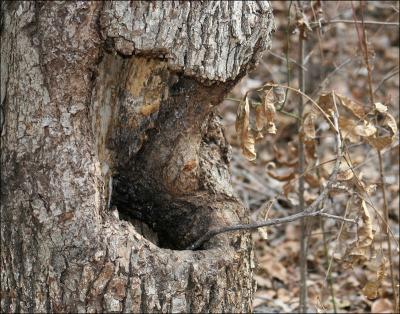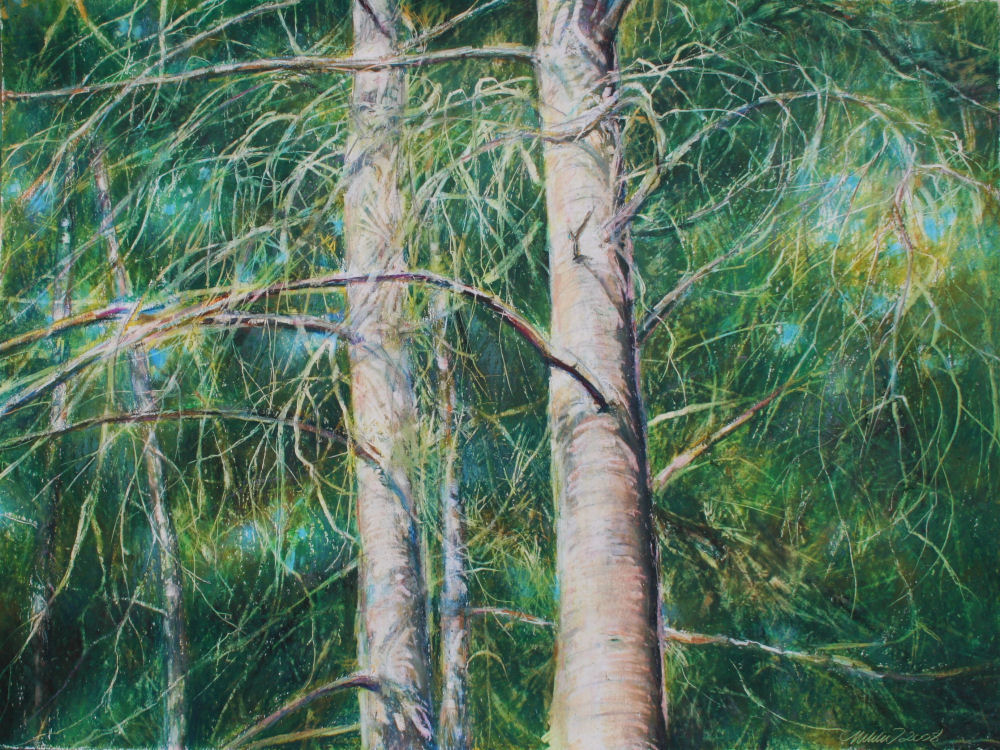trees
« Previous Entries Next Entries »Myrtle At The Zoo, March 10 – April 2
Wednesday, April 2nd, 2008
Myrtle at the Zoo, Crepe Myrtle branches and seed-pods, 20H x 34W x 2D inches acrylics on canvas study, sides painted. Posts here go back to the start of work, sharing the process.
I’ve learned a lot and enjoyed playing with different ideas. It’s been interesting teetering back and forth between frustration and fun, but sometimes that’s what painting is all about. There’s been such a tension over this one as with no other painting, where the urge to throw it away is pitted against the determination to see what could happen. I still like a lot of things in it, such as the technique of dripping paint down the front that I’ve tried in previous paintings. Dripping re-energized the painting and me, and took the work in unexpected directions.
April 1st: 1. dripped violet across the top and deep yellow from the bottom. This move brings about a new set of problems that may lead the way to what I’m searching for; could be that recovery is impossible 2. Later notes after one days of work, Apr.1st: I like where the drips made me go…sometimes you’ve gotta take a leap.
March 27th – 30th The zebra is too prominent no matter what I try to blur it into the background, so more branches have been added to the foreground.

March 20th – 26th: After another few days of remapping, I like the direction it’s taking with the larger Myrtle seed-pods in the foreground…hardly touched the zebra, except before starting today, scrubbed and washed off a lot of the surface and concentrated mainly on re-working the whole composition.
Art in general, no matter what the media, has us confront varying emotions while we work, pleasant and unpleasant. If the piece is taking longer than anticipated, any self-expectations that mount don’t help the progress at all. There are also echos of things other Artists say, like “if it’s taking too long, trash it and start over”. That one always puzzles me – why tell someone to quit? How about searching for all that the work might possibly become? Fear of ruining work that’s already accomplished can hold us back from throwing our whole selves into it, bringing it to a new level.
It seems that so much fuss is made about paintings that are whipped off in a day. While the method of finishing work quickly is great, this is not the ideal for every painter. Most paintings do have a lot of life and zing after only one day of work and sometimes it’s best to leave them that way. Some Art is best left as “pure”, responsive, raw… and some work begs to be analyzed and dissected, perhaps to the death of the piece and having nothing to show for the labor.
Each artist knows if each painting at the end of the day has potential to become something more, and the decision to stay or to search is different with each and every piece. I say don’t give up if a painting takes too long to come to fruition.
March 15th – Freestyle brushstrokes have livened work up a little since the last post. Intentions are for the painting to be more about the Myrtle than the zebra, but the zebra is key to determining the rhythm of the whole composition. The biggest challenge is that the zebra is such a striking subject alone, and competes for importance with the branches. Color is a huge issue also, because the ground is dry and bright during winter, but so is the zebra. This is why I have yellow tones in the ground, and gradually am adding darker values, playing with colors throughout the painting process.
Every aspect is gradually worked through as painting progresses; no definite decisions made until the final day. If/when work finally succeeds, all the stages of color transitions show through in bits and pieces across the canvas, contributing to the final color and depth impressions. It’s really the process of change in a painting that’s most enjoyable and educational. Every stage is photographed or scanned, and the process can be evaluated after it’s finished.
– am finding it hard to maintain a balance of weight on the right and left sides beside such strong tones in that fur…I may add is a couple of unusually large detailed seed-pods in the foreground to take the eyes’ attention away from the zebra at first glance. I keep playing with colors, patterns, brushstrokes, scratching/removal of paint and anything I can think, still aware that the painting needs more depth.
March 10th – striving for an accurate portrayal of Crepe Myrtle branches in winter, and except for a few detailed seed-pods in the foreground, an overall abstract representation more than realism. The zebra is purposely off-center in an attempt to allow more space for the main subject. Establishing the composition is always priority over accurate colors at first, which of course are to be considered but like other details are left until the final day of completion.
Eastern Redbuds
Saturday, March 29th, 2008
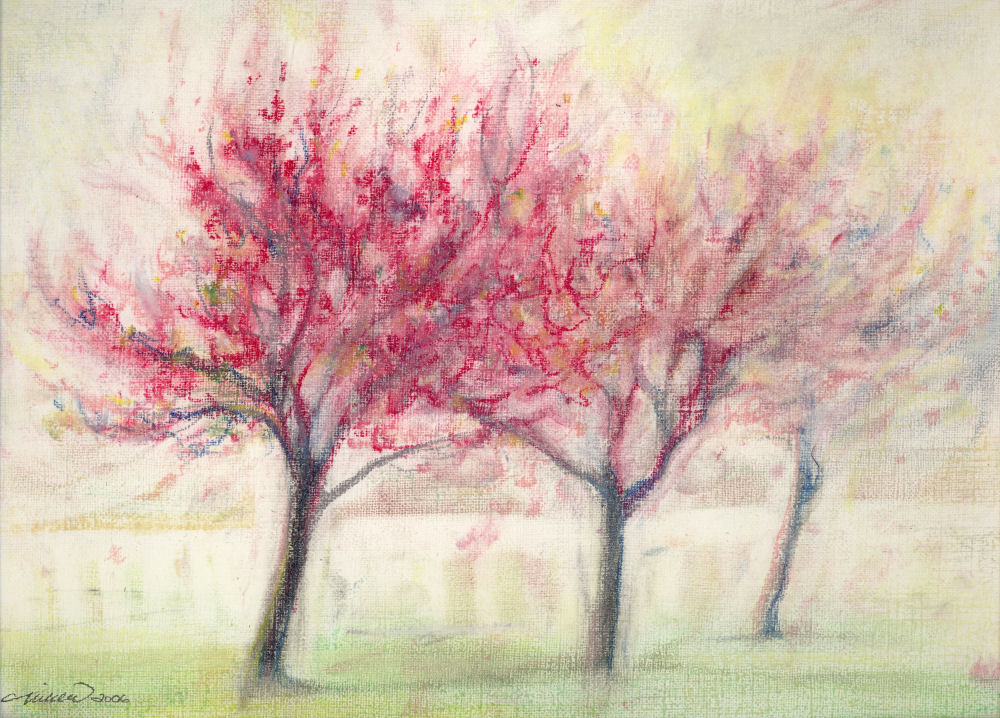
Eastern Redbuds, Coppell, Texas USA, 14 x 11 inches soft pastels on paper.
Showcased in Artjury.com’s 2007 Spring/Summer Online Exhibition.
Snow
Tuesday, March 4th, 2008
75*F a couple of days ago, and snow last night. Spring temps here in northern Texas go from one extreme to the other.
Mockingbird
Wednesday, February 27th, 2008
This week mating season has started for Mockingbirds in northeast Texas. Mockingbirds mimic over 120 bird calls, and I’m guessing there are a couple of frog calls in the mix too. Really interesting, and a sound I love hearing when outside doing yardwork.
Guanacaste Trees
Monday, February 25th, 2008
Guanacaste Trees, Costa Rican Grasslands, 11H x 14W inches oil pastels on paper. Part of the Paper Places series, all have white double mats and white custom built wood frames with crackle finish, total size 22H x 26W inches.
The unusually wide umbrella-like shape of the trees look cartoonish, but with a few textures I think the issue is resolved now.
Guanacaste trees have such presence! Costa Rica is not well known for its open grasslands, but north-west and central areas of the country flatten out a little, with mountains of rain forests and volcanoes on the horizon. Guanacaste trees look entirely different growing in the rain forest than on the open grasslands.
The Great Ocean Road
Sunday, February 24th, 2008
The Great Ocean Road, east coast Victoria, Australia, 11H x 14W inches oil pastels on paper, framed with 3 inch white double mat, brass title plate, and white wood frame with crackle finish, 22H x 26W inches total size. Sold.
Palo Verde tree in bloom at a nursery in Ajijic, Mexico
Friday, February 15th, 2008
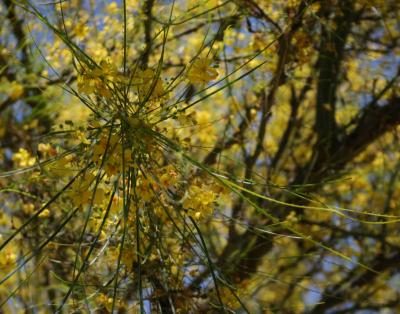
Palo Verde tree in bloom at a nursery in Ajijic, Mexico
Fire Ants feeding on sap
Saturday, February 9th, 2008
Even if we think nothing is happening…it is. Today I went for a walk through my favorite park in Coppell, and my peripheral vision noticed tiny ant-highways up and down a few trees, so I stood and admired them for a while.
February Yawn
Tuesday, February 5th, 2008
Even the trees are bored with winter!
Eastern White Pine
Friday, February 1st, 2008
Eastern White Pine 18 x 24 inches oil pastels on paper, professionally framed, total size 21 x 27 inches. Sold.
Finished today, and the first drawing in a long time that I didn’t stop to document along the way…that breaks the momentum of work sometimes. This one kind of flew out for a change! It can be viewed in Arlington, Texas at AVAA’s 32nd Annual Regional Juried Art Exhibit, February 15 – March 28, 2008.
« Previous Entries Next Entries »

